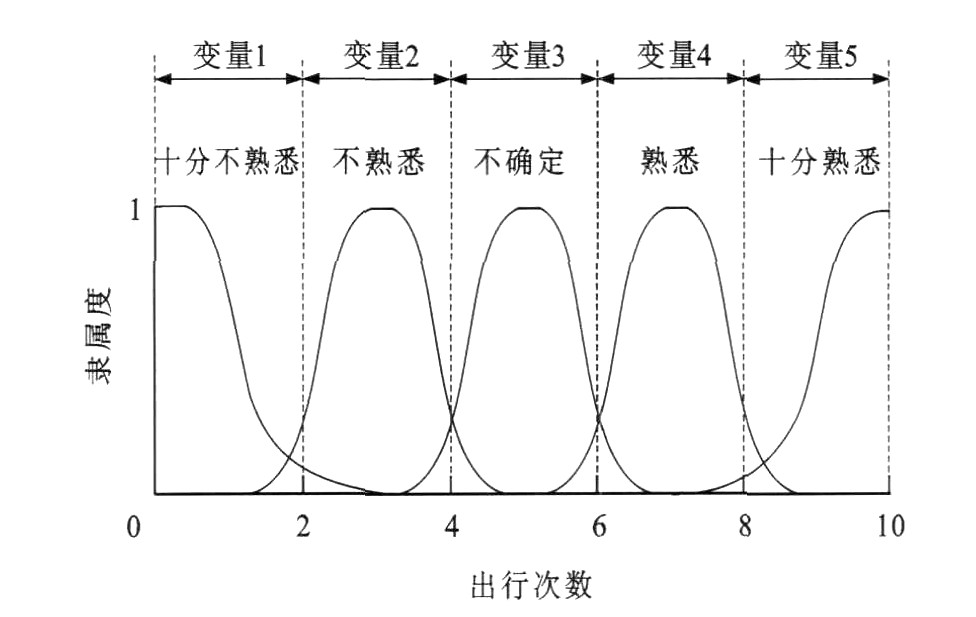Hybrid evacuation population estimation model based on fuzzy logic and discrete choice model
-
摘要: 为了合理预测潜在危险区域人员是否参与疏散的决策行为, 以模糊逻辑与离散选择模型为理论基础, 构建了能够反映影响人员疏散决策行为的因素及其影响程度的混合预测模型。该模型以二项Logit模型为主体结构, 兼用模糊逻辑对主观、定性变量进行处理, 在显著性分析的基础上, 筛选对疏散决策行为影响较大的解释变量并确定其在效用函数中的系数。采用美国Andrew飓风的疏散行为调查数据, 估计和测试了该混合模型, 并将其与以往相关模型的预测结果进行了对比。分析结果表明: 该混合模型对测试样本的预测准确度达到了85%, 相对于以往的疏散行为预测模型, 对于调查数据具有更高的拟合度和更好的预测效果。Abstract: In order to predict the personnel decision behaviors in potential dangerous areas about participating evacuation or not reasonably, a hybrid model was presented based on fuzzy logic and discrete choice model, which could reflect the influencing factors and degrees for evacuation decision behavior.The binary Logit model structure was used to construct the hybrid model, and fuzzy logic was adopted to capture subjective and qualitative variables.Based on the analysis of significance, the influencing factors of evacuation decision behavior and their responsible coefficients in utility function were determined.The evacuation behavior surveying data after hurricane Andrew in America were used to estimate and test the hybrid model, and its result was compared with that of relative models.Analysis result indicates that the prediction accuracy of the hybrid model reaches 85%, so the hybrid model has a higher fitting degree and a better prediction efficiency.
-
Key words:
- traffic management /
- traffic evacuation /
- population estimation /
- fuzzy logic /
- binary Logit model
-
表 1 模糊if-then规则
Table 1. Fuzzy if-then rules
解释变量 前件 后件 对于不参与疏散所能导致伤害的感知(主观性) if严重 then他/她参与疏散 if不严重 then他/她不参与疏散 疏散者对房屋能够承受风暴能力的感知(主观性) if强 then他/她不参与疏散 if弱 then他/她参与疏散 接收到的疏散交通管理者发布的定性信息(语言性的定性信息) if交通运行条件差 then他/她不参与疏散 if交通运行条件好 then他/她参与疏散 表 2 RP调查数据
Table 2. RP survey data
解释变量 分类(哑变量) 人数 百分比/% 是否参与了疏散 是 290 70.7 否 120 29.3 住房类型(H) 单家庭住房(H1) 219 53.4 多家庭住房 103 25.1 移动式住房(H2) 88 21.5 是否有飓风疏散经验(E) 是 300 73.2 否 110 26.8 年龄(A) ≤18(A1) 89 21.7 19~49(A2) 255 62.2 ≥50 66 16.1 是否接到疏散指令(O) 是 356 86.8 否 54 13.2 疏散者对于不参与疏散所能导致伤害的感知(P) 严重 195 47.6 不严重 215 52.4 疏散者对房屋能够承受风暴能力的感知(Pw) 强 189 46.1 弱 221 53.9 接收到的疏散交通管理者发布的定性信息(I) 交通状况好 260 63.4 交通状况差 150 36.6 表 3 SP调查数据
Table 3. SP survey data
疏散指令类型(T) 强制型(T1) 建议型(T2) 自愿型 人数 百分比/% 人数 百分比/% 人数 百分比/% 参与疏散(y=1) 389 94.8 265 64.6 127 30.9 不参与疏散(y=0) 21 5.2 145 35.4 283 69.1 表 4 变量选择结果
Table 4. Selection results of variables
解释变量 自由度 步数 0 1 2 3 4 5 H1、H2 2 < 0.001 < 0.001 < 0.001 < 0.001 < 0.001 < 0.001 A1、A2 2 0.021 0.014 < 0.001 < 0.001 < 0.001 < 0.001 O 1 0.045 0.033 0.032 0.003 0.002 0.001 T1、T2 2 0.056 0.054 0.034 0.009 0.007 0.005 Ωp(P) 1 0.089 0.078 0.056 0.053 0.052 0.050 表 5 模型估计结果
Table 5. Estimation results of model
解释变量 系数 标准差 Wald值 自由度 假设检验p值 常数项 1.80 0.67 5.43 1 0.015 单家庭住房 -1.34 0.52 12.45 1 0.000 移动式住房 2.43 0.12 5.15 1 0.018 年龄不大于18 1.22 0.34 4.31 1 0.023 年龄为19~49 0.13 0.25 2.34 1 0.043 是否接到疏散指令 2.87 0.37 13.12 1 0.000 强制型疏散指令 1.89 0.39 21.22 1 0.000 建议型疏散指令 0.86 0.54 9.28 1 0.004 疏散者对于不参与疏散所能导致伤害的感知 2.67 0.42 19.23 1 0.000 表 6 预测结果对比
Table 6. Comparison of prediction results
模型 Cox-Snell检验ρ2值 Hosmer-Lemeshow检验p值 似然比检验p值 准确预测所占的百分比/% 参与疏散 不参与疏散 整体 二项Logistic回归模型[6] 0.25 0.049 < 0.001 74 74 74.0 神经网络模型[6] — — — 76 83 79.5 本文所提出的混合模型 0.21 0.051 < 0.001 82 88 85.0 -
[1] LI U Ying. An integrated opti mal control systemfor emer-gency evacuation[D]. College Park: University of Maryland, 2007. [2] COVA TJ, JOHNSONJ P. Anetworkflow model for lane-based evacuation routing[J]. Transportation Research Part A: Policy and Practice, 2003, 37(7): 579-604. [3] SOUTHWORTH F. Regional evacuation modeling: a state-of-the-art review[R]. Oak Ridge: ORNL, 1991. [4] MOHSENJ, IZZAT B, ALI M. Technological advances in evacu-ation planning and emergency management: current state of the art[R]. Camden: Rutgers State University, 2003. [5] SISIOPIKU V P, JONES S L, SULLI VAN A J, et al. Regional traffic si mulation for emergency preparedness[R]. Birmingham: University of Alabama at Birmingham, 2004. [6] MEI B. Development of trip generation models of hurricane evacuation[D]. Baton Rouge: Louisiana State University, 2002. [7] PEETA S, YUJ W. A hybrid model for driver route choice incorporating en-route attributes and real-ti me information effects[J]. Networks and Spatial Economics, 2005, 5(1): 21-40. [8] 汪德刚, 孟艳平, 宋雯彦, 等. 模糊相似度推理算法及其构造的模糊系统逼近性能的分析[J]. 工程数学学报, 2009, 26(3): 423-430. https://www.cnki.com.cn/Article/CJFDTOTAL-GCSX200903009.htmWANG De-gang, MENG Yan-ping, SONG Wen-yan, et al. Analysis of fuzzy si milarity-based reasoning method and approxi mation properties of corresponding fuzzy systems[J]. Chinese Journal of Engineering Mathematics, 2009, 26(3): 423-430. (in Chinese) https://www.cnki.com.cn/Article/CJFDTOTAL-GCSX200903009.htm -





 下载:
下载:



